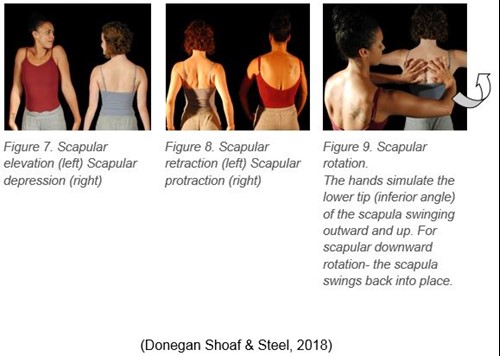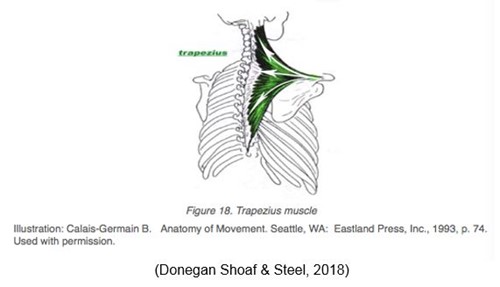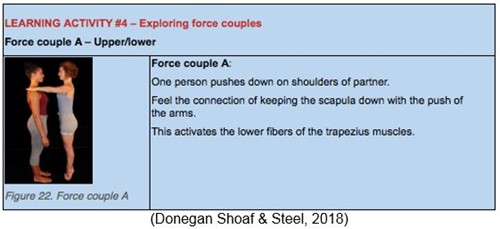The shoulder complex: An exploration of the scapula
Author: Martha Wiekens on behalf of the IADMS Dance Educators’ Committee
I am very excited to write this blog post introducing a brilliant new resource paper on the shoulder complex, which has been written by Lisa Donegan Shoaf and Judith Steel. The paper provides an in depth look at the shoulder complex, starting with anatomy and specific muscular force couples, then moving onto the integration into whole body movement and common dancer issues relating to the shoulder. Throughout the paper there are guided learning activities that can be used in class to help students fully understand this area of the dancer’s body. In this blog post we will introduce and explore one of the anatomy structures, the scapula (shoulder blade), following the learning activities and ideas presented in the paper. You can read the resource paper here.
Anatomy
Optimal functioning of the shoulder complex is really important to allow correct alignment, maximum range of motion and then ideally full artistic expression. Being able to visualize the anatomy of the shoulder complex is helpful in beginning to understand this idea of optimal functioning. To pick one component of the anatomy of this area let’s look at the scapulae (shoulder blades). The scapulae sit on the back of the rib cage and help to form the socket part of the shoulder’s ball and socket joint where it meets the humerus (upper arm bone).
Have a look at this interactive 3D model of the skeleton’s shoulder complex and explore the location of the scapula in its position and the other bones that make up the shoulder complex.
Joint movements
The scapulae have a lot of movement possibilities and these play an important part in efficient movement of the shoulder joint. The photos below, taken from the shoulder complex resource paper, show the movements of the scapula.

The resource paper includes useful learning activities that can be used to help students with learning the joint motions and how to apply them to dance movements. A particularly useful activity, which relates to the photos above is Learning Activity #2. Using the movement terms related to the scapula mentioned above, students have found it useful when challenged to devise dance movements and then practicing using the correct terms to describe the movements.

Force couples
As we know muscles move our skeleton and create the movements of the scapulae we have just explored. There are a number of key muscles within the shoulder complex it’s important to highlight, particularly when it comes to optimal functioning of the whole shoulder complex, as both mobility and stability are required at different times. The paper explains the idea of force couples when exploring the muscles of the shoulder complex to help students understand this. A force couple being something that has a pull in one direction and a counter pull in another, ideally stabilizing the structure they are pulling on, in this case the scapula.
However these force couple can become uneven, so one pulling more than the other and this disrupts the efficient rhythm of the shoulder complex movement. A common area with an imbalance of the force couple is in the trapezius muscle (shown in the diagram below) between the upper and lower trapezius muscles.

As you can see from the arrows in the diagram above, the upper trapezius is able to pull the scapula upwards, but the lower parts of the trapezius is able to pull the scapula downwards. Commonly the upper trapezius fibers are tighter and the lower trapezius fibers weaker, which creates an imbalance and often the scapula tends to ride up higher, rather than remain stable on the back of the rib cage. To understand this within the movement take a look at this interactive 3D model showing the trapezius in action when lifting the arm up above your head or through 1st to 5th position or 2nd to 5th position.
Learning Activity #4 (see below) is an experiential activity relating to the lower and upper trapezius muscle, and is really useful to help dancers feel this force couple in action.

Common dancer issues
Movement dysfunction around the shoulder complex is relatively common among dancers and it is important for teachers and students to understand these. The paper provides excellent cueing ideas to help teachers and dancers address this issue. In relation to the scapula a common area of dysfunction is due to a lack of upward rotation when the arms are taken overhead, like in port de bras for example. Often the upper back is particularly tight and muscles such as the lower trapezius (explored earlier) are weak. Some of the cueing ideas from the paper are highlighted below:
“Think of allowing the arm to lengthen before moving”
“Once the dancer begins to move the arms provide the cue to allow the shoulder blade to move up and away”
To fully understand the shoulder complex and when mobility versus stability is required have a look at the full resource paper, which will guide you through more learning activities and the other key areas/aspects of the shoulder complex. Exploring this area of the body through text, interactive anatomy resources as well as experiential learning activities is a great way to support students in understanding the shoulder complex. This area of the body is not often focused on so it’s great to have such a brilliant and in-depth dance specific resource available. Optimal functioning of the scapula is key in correct movement patterning of the whole body, so in my opinion well worth taking time to explore in class with students.
References and useful resources
Clippinger, K. Dance Anatomy and Kinesiology 2nd ed. Champaign, IL: Human Kinetics, 2016.
Donegan Shoaf, L. Steel, J. “Integrating the shoulder complex to the body as a whole: Practical applications for the dancer.” IADMS Resource Paper. Available here. 2018 https://www.iadms.org/page/186?
Paine, R., & Voight, M. L. (2013).”The role of the scapula” Journal of Sports Physical Therapy, 8(5), 617–629.
Urmston, E. “Irene Dowd: The relationship of the scapulae and thorax whilst dancing. Reflections from the IADMS Annual Meeting, Houston, 2017” [Blog] The IADMS Blog. Available here. 2017
Martha Wiekens MSc, PGCHE, FHEA is an Independent Dance Fitness Educator and Injury Rehabilitation trainer based in the UK.
Martha’s LinkedIn profile